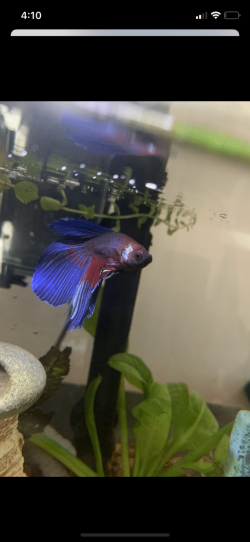You are using an out of date browser. It may not display this or other websites correctly.
You should upgrade or use an alternative browser.
You should upgrade or use an alternative browser.
Columnaris on Betta?
- Thread starter cherryshrimp
- Start date
April FOTM Photo Contest Starts Now!

🏆 Click to enter! 🏆
cherryshrimp
New Member
He’s Australian no? Probably still snoozing.
Columnaris normally starts on the mouth and spreads over the face and head.
The white patch on the gill cover could be fungal or external protozoan. Salt should help. Before you add salt, check the water quality for ammonia, nitrite, nitrate and pH, and then do a 75% water change and gravel clean the substrate. Make sure any new water is free of chlorine/ chloramine before it's added to the tank.
Clean the filter too is it hasn't been done in the last 2 weeks. Wash filter media/ materials in a bucket of tank water and re-use the media. Tip the bucket of dirty water on the lawn/ garden.
---------------
You can add rock salt (often sold as aquarium salt) to the aquarium at the dose rate of 1 heaped tablespoon per 20 litres of water. If there is no improvement after 48 hours you can double that dose rate so there is 2 heaped tablespoons of salt per 20 litres.
If you only have livebearers (guppies, platies, swordtails, mollies), goldfish or rainbowfish in the tank you can double that dose rate, so you would add 2 heaped tablespoons per 20 litres and if there is no improvement after 48 hours, then increase it so there is a total of 4 heaped tablespoons of salt per 20 litres.
Keep the salt level like this for at least 2 weeks but no longer than 4 weeks otherwise kidney damage can occur. Kidney damage is more likely to occur in fish from soft water (tetras, Corydoras, angelfish, gouramis, loaches) that are exposed to high levels of salt for an extended period of time, and is not an issue with livebearers, rainbowfish or other salt tolerant species.
The salt will not affect the beneficial filter bacteria but the higher dose rate (4 heaped tablespoons per 20 litres) will affect some plants and some snails. The lower dose rate will not affect plants, shrimp or snails.
After you use salt and the fish have recovered, you do a 10% water change each day for a week using only fresh water that has been dechlorinated. Then do a 20% water change each day for a week. Then you can do bigger water changes after that. This dilutes the salt out of the tank slowly so it doesn't harm the fish.
If you do water changes while using salt, you need to treat the new water with salt before adding it to the tank. This will keep the salt level stable in the tank and minimise stress on the fish.
The white patch on the gill cover could be fungal or external protozoan. Salt should help. Before you add salt, check the water quality for ammonia, nitrite, nitrate and pH, and then do a 75% water change and gravel clean the substrate. Make sure any new water is free of chlorine/ chloramine before it's added to the tank.
Clean the filter too is it hasn't been done in the last 2 weeks. Wash filter media/ materials in a bucket of tank water and re-use the media. Tip the bucket of dirty water on the lawn/ garden.
---------------
You can add rock salt (often sold as aquarium salt) to the aquarium at the dose rate of 1 heaped tablespoon per 20 litres of water. If there is no improvement after 48 hours you can double that dose rate so there is 2 heaped tablespoons of salt per 20 litres.
If you only have livebearers (guppies, platies, swordtails, mollies), goldfish or rainbowfish in the tank you can double that dose rate, so you would add 2 heaped tablespoons per 20 litres and if there is no improvement after 48 hours, then increase it so there is a total of 4 heaped tablespoons of salt per 20 litres.
Keep the salt level like this for at least 2 weeks but no longer than 4 weeks otherwise kidney damage can occur. Kidney damage is more likely to occur in fish from soft water (tetras, Corydoras, angelfish, gouramis, loaches) that are exposed to high levels of salt for an extended period of time, and is not an issue with livebearers, rainbowfish or other salt tolerant species.
The salt will not affect the beneficial filter bacteria but the higher dose rate (4 heaped tablespoons per 20 litres) will affect some plants and some snails. The lower dose rate will not affect plants, shrimp or snails.
After you use salt and the fish have recovered, you do a 10% water change each day for a week using only fresh water that has been dechlorinated. Then do a 20% water change each day for a week. Then you can do bigger water changes after that. This dilutes the salt out of the tank slowly so it doesn't harm the fish.
If you do water changes while using salt, you need to treat the new water with salt before adding it to the tank. This will keep the salt level stable in the tank and minimise stress on the fish.
Latest Discussions
- Replies
- 1
- Views
- 11
- Replies
- 4
- Views
- 87
trending
-
-
-
-
F-1 Angel... a bit nervous... it'll be my 1st F-1 fish...
- Started by Magnum Man
- Replies: 12
-
Staff online
-
GaryEModerator
Members online
Total: 345 (members: 6, guests: 339)



